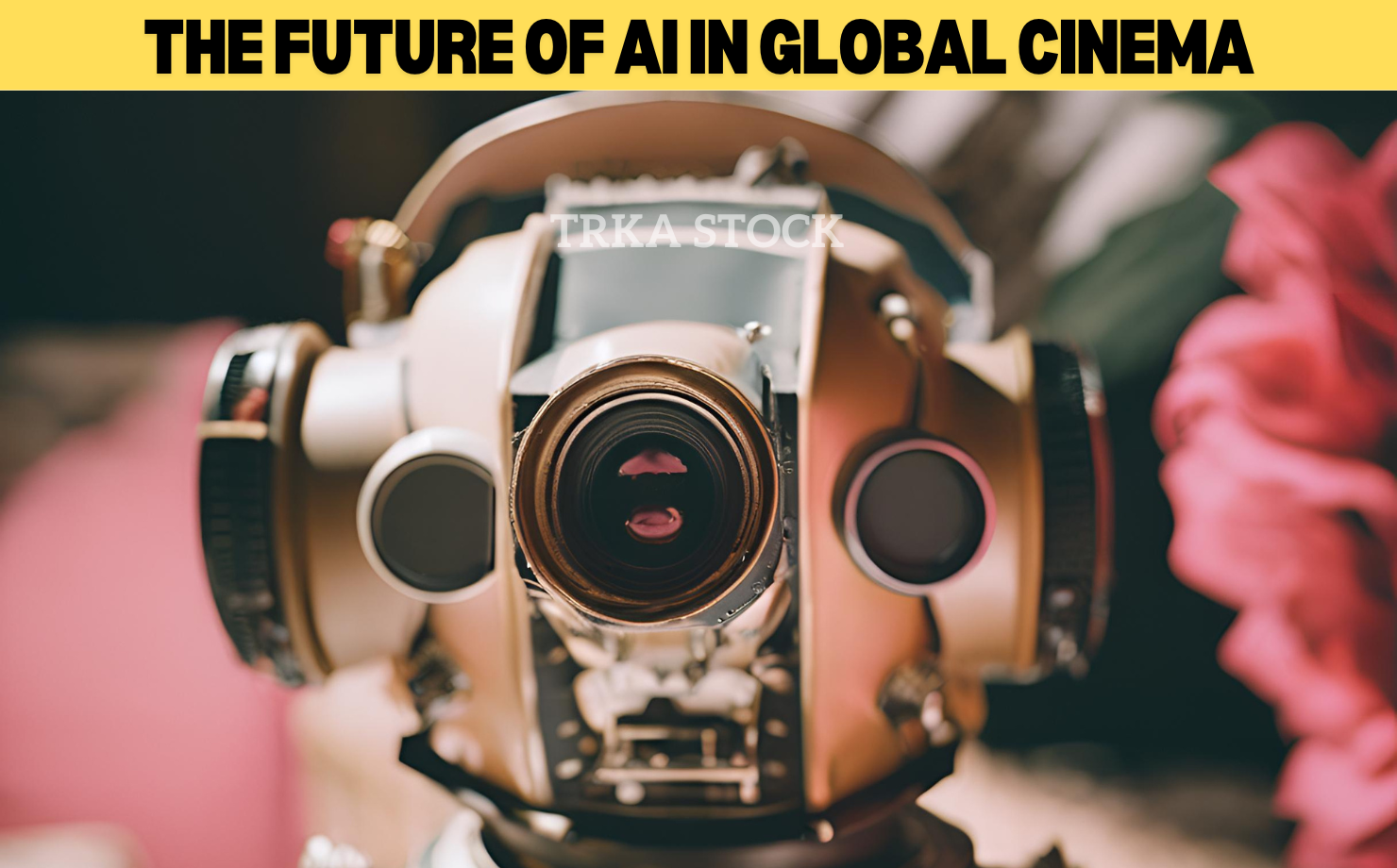Summary – AI’s Impact on Global Cinema
AI is transforming global cinema by overcoming language barriers with advanced dubbing, creating accessible content for hearing and visually impaired audiences, and personalizing film experiences. From content creation to targeted marketing, AI ensures cinema is more inclusive, accessible, and relatable to diverse audiences worldwide.
AI’s Role in Making Global Cinema More Inclusive and Accessible
Technology has always played a key role in shaping how stories are narrated and consumed in this ever-changing landscape of cinema. Advances in technology have continually expanded the boundaries of possibility, from the development of film sound to the shift from film to digital. Among many emerging technologies, Artificial Intelligence is one of the most transformative forces at work today within the global film industry. AI is not merely a filmmaker’s tool but a catalyst to make cinema all the more inclusive and accessible to audiences across the world.

AI overcomes linguistic barriers to facilitate the following:
One of the largest barriers to more international cinema has always been language. Traditional solutions like subtitles and dubbing make films available to non-native speakers, but each is full of problems. Sometimes subtitled films are distracting to the viewer to read, while traditional dubbing often lacks nuance and authenticity present in the original performances. That is where AI steps offering novel solutions that bridge these gaps more effectively.
An important example of such innovation in the film industry is dubbing AI. All because of this dubbed AI, it’s now possible to translate and dub movies with much authenticity and emotional depth that was not possible before. Unlike any conventional method, AI-driven dubbing can analyze the tone, inflection, and emotion of the original actor to ensure the dubbed version is going to have the same impact as the original version. Not only does this retain the originality of the film, but it also presents the movie to a viewer of a different linguistic background in a manner that is probably highly authentic and more engaging.
AI can further create subtitles in several target languages at once, making films more accessible to other viewers across the world. It does this rapidly and efficiently, thereby freeing filmmakers from having to wait for the usual delays that have to be taken in manually translating and producing subtitles for other regions. This will finally make world cinema all-inclusive, as varied audiences get their chance to experience content in native languages.
Global Cinema – Table
| Aspect | AI’s Role in Global Cinema |
|---|---|
| Overcoming Language Barriers |
|
| Enhancing Accessibility |
|
| Content Creation |
|
| Democratization of Filmmaking |
|
| Marketing and Distribution |
|
| Future of AI in Cinema |
|
Accessibility Enhancement for Hearing and Visually Impaired
While AI is breaking down the language barrier, it is making cinema accessible to both hearing and visually-impaired film consumers. In the case of hard-of-hearing viewers, AI-produced subtitles and captions can be personalized with in-depth descriptions of sound effects, music cues, and even emotional tone within the dialogue. It’s well beyond a matter of transcription; that level of detail enriches the experience for this group.
This AI system brings advanced audio description capabilities, analyzing the visual aspects of a movie and developing live-action descriptions synchronized with what transpires on screen. It therefore allows visually impaired viewers to comprehend the movie and fully appreciate it; they get a full, detailed, audio narration of the scenes regarding location, actions of characters, and facial expressions.
AI is even working on haptic feedback mechanisms that will reproduce visual information into touch. For example, AI can generate patterns of vibrations corresponding to some of the visual cues in a movie so that visually impaired viewers can “feel” the action unfold. This multisensory approach to storytelling opens up accessibility in cinema and creates magic for all.
The Role of AI in Content Creation – Global Cinema
Aside from making the existing movies more accessible, AI has also gradually started to play a very important role in the development of new content. Filmmakers, for the most part, can resort to the use of AI in writing screenplays, editing the footage, and sometimes even completely new scenes. Capable of analyzing vast data amounts, including audience preferences and box office trends, these AI tools help filmmakers create stories that reverberate across global audiences.
AI could also be used to make unique versions of films. Imagine an AI system that analyzes a viewer’s preference and generates a version of the film that fits their taste better. This would be realized through the emphasis on particular plot points, changing the pace, or even changes in the ending of the movie. This level of personalization not only adds to the viewing experience but also makes sure the movies are made more inclusive by catering to the diverging tastes and preferences of an international audience.
Furthermore, AI-driven platforms are easing the process of creation and distribution for independent filmmakers. Starting with editing and special effects right through to marketing and distribution, these platforms use AI to do the job, further opening quality filmmaking opportunities for low-budget filmmakers whose productions can run neck and neck in competition with their big-budget predecessors. This democratization of filmmaking is opening new avenues for different voices to be represented, allowing global cinema to be more inclusive with regard not only to the stories being told but also to whose perspective gets told.
AI in Film Marketing and Distribution
The role of AI in world cinema does not end with the creation and consumption of movies. It is changing how movies are marketed and distributed. AI algorithms can process data from audiences to spot the most effective marketing strategies for various regions and demographics. This ensures that films reach the right target audiences, promoting their possibilities of achieving commercial success.
This would further ensure that AI optimizes the movie distribution by predicting which markets would be most receptive to certain types of content. Filmmakers and distributors will, therefore, have room to make informed decisions about where and when to release their films for better reach and impact. The more efficient and targeted the process of distribution becomes, the more AI will contribute to ensuring films from all parts of the world find their audience regardless of the barriers of language or culture.
More so, AI allows for better localization of film content. Through advanced machine learning methods, AI can also help in fitting marketing materials, trailers, and even the content itself to the peculiar tastes of different cultures. This kind of localization ensures that worldwide audiences would get a version of the film adapted to their cultural setting and, thus, more relatable and palatable.

The Future of AI in Global Cinema
But with further development, the role of AI in world cinema will only continue to increase in importance. Already today, technology is breaking barriers among languages, making cinematic products more accessible to a wide circle of viewers. With more advanced AI-created tools in the offing, greater novelties may be expected in the sphere of filmmaking, marketing, and consumption.
For example, AI will most likely be the central driving element for the creation of new kinds of cinematic experiences, like VR and AR films. Immersive technologies have immense capabilities that can revolutionize the way we experience cinema. And AI is going to be right at the center of making those experiences all-inclusive for any user.
As development continues, AI will become even more applied to filmmaking from pre-production to post-processing. Filmmakers will lean increasingly on AI to enrich their ability to tell stories that captivate the world’s audiences, thus keeping cinema a strong tool for cultural understanding and exchange.
Conclusion
Whereas it transforms the making and consuming of movies and assists with making world cinema more inclusive and accessible, AI helps make the world community across the globe inclusive and accessible. The AI for dubbing breaks down the language barriers, and the development of the best AI apps ensures accessibility to movies by persons with disabilities or language barriers in any corner of the world. One could say, looking forward, AI is sure to be one of those features that continue to push global cinema toward further inclusivity and diversity, and ease of access, than has ever been possible.
Global Cinema FAQ
How is AI making global cinema more inclusive?
AI is breaking down language barriers and improving accessibility for people with disabilities, making cinema more inclusive for diverse audiences worldwide.
What role does AI play in dubbing films?
AI-driven dubbing analyzes tone, emotion, and inflection to create authentic and emotionally resonant dubs that retain the original film’s impact.
How does AI enhance accessibility for the hearing and visually impaired?
AI generates detailed subtitles, personalized captions, audio descriptions, and haptic feedback, making films accessible to those with hearing or visual impairments.
Can AI create personalized versions of films?
Yes, AI can tailor films to individual viewer preferences by emphasizing certain plot points or changing the pace, enhancing the viewing experience.
How does AI help independent filmmakers?
AI-driven platforms assist with editing, special effects, marketing, and distribution, making it easier for independent filmmakers to compete with big-budget productions.
What is AI’s role in film marketing and distribution?
AI analyzes audience data to optimize marketing strategies, predict receptive markets, and ensure films reach the right audiences efficiently.
What is the future of AI in global cinema?
AI will continue to enhance filmmaking, marketing, and consumption, with potential developments in VR, AR, and immersive cinematic experiences.

